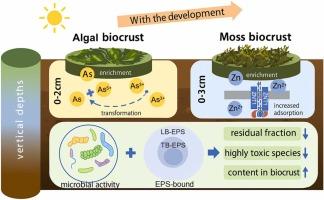Vertical migration and transformation of metal(loid)s in surface layers of tailings ponds driven by induced biocrusts: Emphasizing arsenic and zinc dynamics
IF 11.3
1区 环境科学与生态学
Q1 ENGINEERING, ENVIRONMENTAL
引用次数: 0
Abstract
The formation of biological soil crusts (biocrusts) constitutes a pivotal initial phase in the natural rehabilitation of heavy metal(loid)-contaminated tailings ponds. Through integrating field studies and culture experiments, we investigated metal(loid) transformation and vertical redistribution dynamics during biocrust succession. Artificially induced biocrusts exhibit distinct developmental timelines: algal crusts established within 20 days, whereas moss crusts exhibited rapid expansion after 40 days. Biocrust development significantly enhanced upward metal(loid) migration, leading to differential enrichment patterns — arsenic (62 %) accumulation predominated in algal crusts, while zinc (25 %) peaked in moss crusts. Metal(loid)s were chelated in tightly bound extracellular polymeric substances (EPS), and the formation of biocrusts increased the residual fraction while reducing bioavailability. With development of algal crusts, As(V) and As(III) were reduced to elemental arsenic. Microbial community analyses revealed compositional shifts, with EPS-producing taxa and Fe/Mn oxide-precipitating microorganisms becoming increasingly abundant. Concurrent molecular analyses identified upregulation of key functional gene involved in arsenic redox transformation and zinc uptake, alongside variations in photosynthetic systems. These findings have provided novel insights into biocrust-mediated biogeochemical cycling in polluted environments.

诱导生物结壳驱动尾矿库表层金属(样态)的垂直迁移与转化——以砷锌动态为重点
生物土壤结皮的形成是重金属污染尾矿库自然修复的关键初始阶段。通过野外研究和培养实验相结合,研究了生物结壳演替过程中金属(loid)的转化和垂直再分配动态。人工诱导的生物结壳具有明显的发育时间表:藻类结壳在20天内形成,而苔藓结壳在40天后迅速膨胀。生物结壳的发育显著增强了金属的向上迁移,导致了不同的富集模式——砷(62%)在藻类结壳中富集,而锌(25%)在苔藓结壳中富集。金属(类)在紧密结合的细胞外聚合物(EPS)中螯合,生物结壳的形成增加了残留部分,同时降低了生物利用度。随着藻皮的发育,As(V)和As(III)被还原为元素砷。微生物群落分析显示,微生物组成发生了变化,产生eps的类群和Fe/Mn氧化物沉淀的微生物数量越来越多。同时进行的分子分析发现,参与砷氧化还原转化和锌吸收的关键功能基因上调,以及光合系统的变化。这些发现为污染环境中生物壳介导的生物地球化学循环提供了新的见解。
本文章由计算机程序翻译,如有差异,请以英文原文为准。
求助全文
约1分钟内获得全文
求助全文
来源期刊

Journal of Hazardous Materials
工程技术-工程:环境
CiteScore
25.40
自引率
5.90%
发文量
3059
审稿时长
58 days
期刊介绍:
The Journal of Hazardous Materials serves as a global platform for promoting cutting-edge research in the field of Environmental Science and Engineering. Our publication features a wide range of articles, including full-length research papers, review articles, and perspectives, with the aim of enhancing our understanding of the dangers and risks associated with various materials concerning public health and the environment. It is important to note that the term "environmental contaminants" refers specifically to substances that pose hazardous effects through contamination, while excluding those that do not have such impacts on the environment or human health. Moreover, we emphasize the distinction between wastes and hazardous materials in order to provide further clarity on the scope of the journal. We have a keen interest in exploring specific compounds and microbial agents that have adverse effects on the environment.
 求助内容:
求助内容: 应助结果提醒方式:
应助结果提醒方式:


